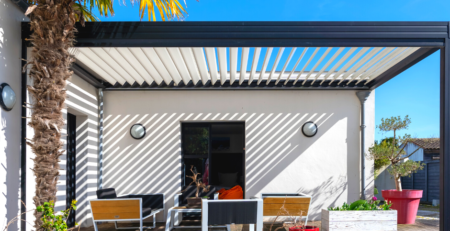Pergola politics
In many older sectional title schemes, life outside your front door can be trickier than you’d expect. You’re not just upgrading a pergola for example – you’re weaving your way through a maze of legislation, body corporate politics, sectional plans and draft sectional plans of extension, participation quotas and variations of them, and a whole lot of “he-said-she-said” at AGMs.
Let’s take a real example.
Recently, we received a query from an owner in a complex, built in the late 1980s, who wanted to install a modern pergola over their exclusive use area (a garden). The original pergolas – made from wood – were installed decades ago. Only some of the units still have them, and many of those have deteriorated or are neglected. The land is termite-infested, meaning the original wooden structures no longer make sense, practically or financially.
The owner simply wants a functional outdoor space that reflects today’s reality – while still respecting the look of the complex. She isn’t trying to push boundaries. In fact, she’s offered a middle-ground: owners can choose the roofing material based on their budgets, but keep a unified structure and appearance. Sounds reasonable, right?
Well… it’s complicated.
When a Pergola becomes a legal matter
At first glance, this seems like a simple improvement. But under the Sectional Titles Schemes Management Act[1] (“the STSMA”), a change like this can trigger a range of legal and procedural requirements – especially if it involves extending a section (like adding permanent coverage to a part of your garden) or altering common property.
In this case, the proposed pergola would be bolted on, not built into the unit – and the owner even offered to remove it upon selling, if needed. So, the question becomes: is it temporary enough to avoid triggering a formal extension of their section? Or does it still require a special resolution as it is a formal extension? Or does it require a unanimous resolution because it is an improvement to common property that is not reasonably necessary? Or if it is reasonably necessary, will it require a special resolution?
Special resolutions vs simple decisions
Here’s the legal reality: if the pergola alters the external appearance of a section in a significant way or if it’s positioned on common property or exclusive use areas (which is common property allocated for the exclusive use of one or more owners), the body corporate needs to approve it. Typically, this happens via a special resolution – which means getting approval from 75% of owners at a meeting (by value and number), or 75% of all owners in writing.
Participation Quotas: the hidden detail
If the pergola is deemed to extend the floor area of the unit, that’s where things get sticky. Extending a section means:
- Updating the sectional plan;
- Recalculating participation quotas (PQs);
- Possibly impacting all the owners’ levies and voting rights; and
- The involvement of the Registrar of Deeds.
This is usually only triggered if the pergola becomes a built-in or walled structure, or enclosed patio – not a temporary shade structure. But trustees and managing agents are often cautious. They’re thinking ahead: What if everyone wants something different? What if it affects resale values?
Valid concerns, but they must be balanced against reality.
Aesthetics and affordability: finding the balance
The proposal in this case aims to strike a thoughtful balance: a consistent visual structure across the scheme, with flexibility in materials to accommodate different budgets. This kind of solution respects both the shared nature of community scheme living and the individual circumstances of owners.
But here’s where community living presents its challenge – even sensible upgrades require consensus. In sectional title schemes, that often means navigating differing views, financial means, and interpretations of what’s “acceptable”. Rules exist to preserve harmony and uniformity, but without careful communication and leadership, they can unintentionally become barriers to progress.
The key lies in building consensus, not avoiding it – ensuring that changes are lawful, transparent, and inclusive, while still allowing the scheme to evolve in a way that benefits all owners over time.
Termites and timber
One major point that stood out in this query: the complex was built on termite-infested land. The original wooden pergolas were never sustainable long-term. Yet, they remain the “approved” structure – even though they are now unsafe, unsightly, and largely abandoned.
Why are schemes so resistant to change that’s both practical and modern?
Part of the reason is legal confusion, and part of it is fear of setting a precedent. But what’s often missing is common sense leadership: trustees willing to evaluate change on its merits, not just its precedents.
This story isn’t about a pergola. It’s about the slow friction that emerges in community schemes between what was and what could be.
If we don’t allow for smart, sensible updates to our shared living spaces, we risk locking ourselves into an outdated future – one pergola at a time.
Got more questions? Our legal advisory specialists are standing by to guide you. Reach out today!
FOOTNOTES:
[1] Act 8 of 2011.





